After spending the better part of February in Vancouver BC, we think that it is one of the world’s best cities to run in. It never gets too cold nor too hot, and there are dedicated running and biking paths on the famed seawall – a paved rim around downtown Vancouver which skirts the edge of the bay surrounding it.
Run a complete loop, and that’s over a half marathon right there. Scenery changes quickly, from the Northern snow clad peaks to urban settings and small beaches on the west. The path around the thickly forested Stanley park is just under 10k, just in case if you’re in the mood for a short happiness filled run. It is a joyous experience.
Like most of the northern West Coast (or Pacific North-west in ‘murica-speak), British Columbia gets its fair share of rain. It might be sunny one day and damp the next, but it is always a good day for a run.
February was mostly rainy, and it provided the perfect setting for testing the new Ultra Boost ST. And how so? Because last year’s Ultra Boost did miserably when it came to anything outsole.
The buttery rubber shredded faster than one could say Ultra Boost, and it was slippery as an Japanese eel slithering on the docks. So when adidas announced that its newest Ultra Boost ST came shod with a Continental rubber outsole, there was ample reason for cheer.
As far as traction goes, it does not disappoint. The Ultra Boost ST’s outsole provides optimal grip on a range of surfaces from paved roads, concrete, and even manhole covers made of metal. Traction is one area where the ST excels at, and you can rest easy even when running in the rain.
And what of the durability, which was a **huge** issue
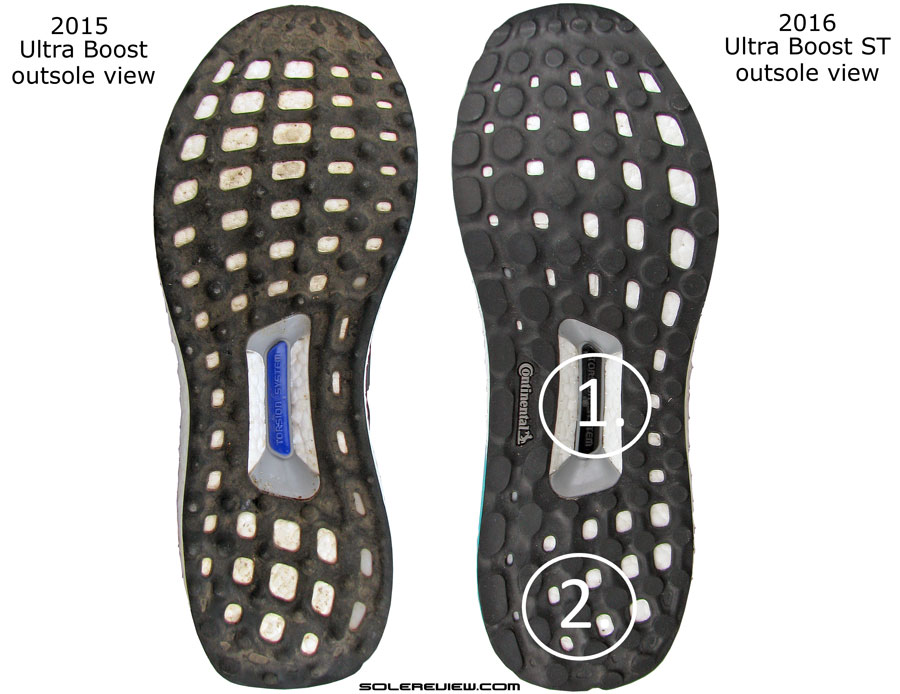
1) Much wider midsole waist. 2) Increased under-heel coverage. (note: this year’s updated Ultra Boost comes with a flat-nubbed Continental outsole. What’s pictured here is last year’s UB with its pointed outsole lugs)
The outsole has a layout similar to the 2015 UB, which happens to be a single sheet of rubber with a windowed design, exposing the Boost foam above it.
The fundamental difference here happens to be the ‘flattened’ profile of the individual rubber nubs, as opposed to the pointy nubs of the UB. By the way, this year’s Ultra Boost update also features this flattened outsole construction.
Which is a smart move. Since the pointed outsole design ended up being flattened anyway
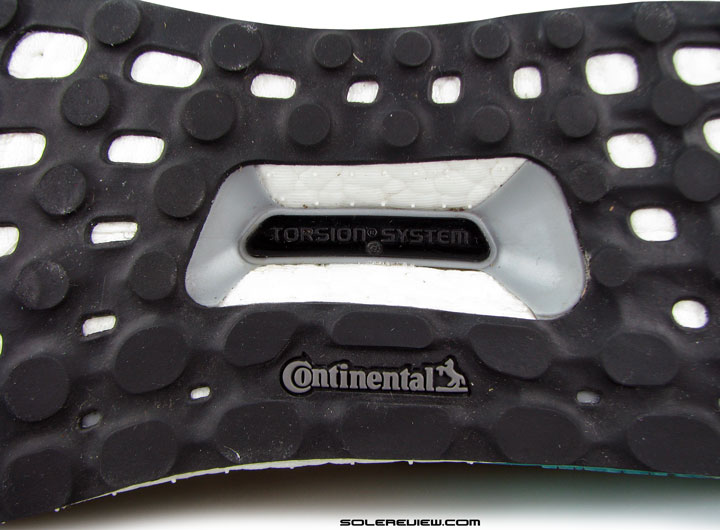
Think of the ST’s Continental rubber as soft car tires. Great on grip, but not quite the interstate cruiser.
Not all Continental stamped soles are the same, and the Ultra Boost ST is proof of that. It is nowhere as durable as the Glide Boost; signs of wear were visible on the ST’s outsole after 40+ miles of road running. Compared to the Glide or Boston Boost’s Continental rubber outsole, the rubber used here is very soft.
The obvious trade-off happens to be durability. While the ST fares better than the 2015 UB’s outsole, the upside isn’t substantial. Everyone likes data, so if we were to throw a subjective number, the ST is around 20% more durable than the quick wearing rubber of last year’s Ultra Boost. So to recap, don’t expect Supernova Glide Boost levels of outsole life – you will not get it.
Let’s pause here for a moment. We’ve gone on and on about the new outsole and how nice Vancouver is, but have said nothing about the actual shoe so far. What exactly is the Ultra Boost ST, and how is it different from the original Ultra Boost? Fair question.
adidas positions the Ultra Boost ST as ‘the ultimate experience in luxurious stability.’ This is slightly misleading, because the Ultra Boost ST is no more of a stability shoe than the Ultra Boost is. It does not belong in the same family as the outgoing adistar Boost or the Sequence Boost.
This isn’t a stability shoe in the conventional sense. The ST isn’t firm, does not come with a harder medial post, and hence does not display any mannerisms expected of a traditional ‘stability’ or ‘support’ shoe.
When speaking of the ST, the Brooks Transcend comes to mind
A very cushioned and planted ride, helped by the wide footprint and tall midsole sidewalls. Another aspect unique to the Brooks Transcend is its prominent feel of under-arch support; this was due to the midsole’s generously foam fill and flare under the arch area.
When seen from that point of view, the adidas Ultra Boost ST is exactly the same. It has neutral ride manners packaged within a highly cushioned experience. And much like the Brooks Transcend, the ST midsole is designed to deliver a noticeable level of under-arch support – with none of the usually associated firmness.
But hey, the ST comes with a medial support structure, does it not? Yes, there is a support element on the inner side of the Boost midsole, but it does not work in the way one would expect.
That said, the green midsole band is far from being purely cosmetic, and comes with a function to perform – but in a very ‘non-motion control’ sort of a way. We’ll delve into that in more detail after we run through the basics.

adidas’ magic potion – a cluster of springy Polyurethane globes fused together in the shape of a midsole.
Let’s begin with the design basics, then. The ST shares aesthetic similarities with its sibling, the Ultra Boost, mainly due to the use of the Primeknit upper, a full length Boost foam midsole and familiar features such as the plastic heel counter and the exaggerated Achilles lip at the back.
By the way, for those who aren’t up to speed on adidas tech, the Boost midsole happens to be a cluster of blown Polyurethane globules molded together. This was developed by BASF, the chemical company, and you can read all about it in our review of the Energy Boost.
Regardless of the visual common ground, the Ultra Boost ST couldn’t be more apart than the non-ST version. The Primeknit upper used on the ST is completely different. While the Ultra Boost featured a stretch compression mesh, the ST mostly sticks to the use of non-stretch Primeknit.

The ST uses a Primeknit upper, but stretchy it is not. Except for the green band around the forefoot, which happens to be slightly elastic.
Only the green mesh area wrapping a section of the forefoot is stretchable (and only partially so), while the remainder is not. If you look closely, there are shiny Lycra strands visible on the green panel.
This makes only the green forefoot band slightly expandable, while the remaining upper area lacks any stretch worth mentioning.
The Lycra fibers are used in areas other than the green forefoot band, but then, a grey knit structure covers those areas and limits the amount of stretch.
It is interesting how adidas has quickly evolved its Primeknit concept; this allows for a range of fit outcomes, which is a good thing. On one hand, you have the ultra snug fitting Ultra Boost, and on the other hand exists a regular fitting ST.
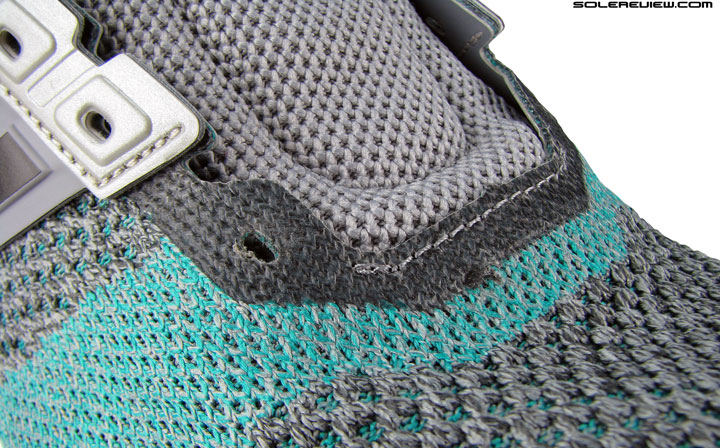
No bootie construction like its namesake; the ST sticks to a traditional lacing design. The first row has a filmic laminate for reinforcement.
The ST cuts in a proper lacing area, instead of relying on a full slip-on design like the UB. So there’s an eye-stay panel with eyelet holes punched in. The ST also stays away from the plastic cage design of the Ultra and Energy Boost , and uses a synthetic leather midfoot panel which joins the lacing at the top.
See adidas? That wasn’t so hard.
While this is infinitely better than the tortuous experience of the plastic panel used on other models, it isn’t perfect for a few reasons. More on this to follow when we get to the detailed upper fit discussion.

The sleeve starts only after the second eyelet from the rear, which leaves room for the tongue flap.

Here’s the familiar Achilles lip from the UB. That said, the edges of the external plastic heel counter are not quite as tall.
A wide inner sleeve made of a thin and stretch fabric lines the midfoot. This is fashioned in the way of adidas models such as the Glide and Sequence Boost; the sleeve begins under the fourth eyelet from the front, leaving a generous margin for the tongue flap to be semi-independent.
The heel area is similar to the UB’s design, save for a few modifications. The collar opening is wider due to the change in the plastic counter molding design. On the Ultra Boost, the hard component was curved inwards, in addition to being taller than the ST’s counter.
That design variance made the collar opening narrower vs. the Ultra Boost ST, and the shoe ended up being comparatively harder to slide into.
The reverse side of the Achilles lip has reflective treatment, which comes through as very bright under low light conditions.
Of all the differences in the upper design compared to the Ultra Boost, none is more significant than the one which happens around the toe-box. adidas must have read all the negative feedback around the Energy Boost’s and Ultra Boost’s super pointy toe-box construction, and what happens on the ST is a very welcome change.
There is a much higher internal stiffener raising the toe-box profile; that area is marked by a grey-ish laminate on the outside. The difference between the toe-bumper profile of Ultra Boost and Ultra Boost ST has to be seen and felt to be believed. The best way to show this is place the toe ends of both shoes side by side. See? The ST has a significantly higher toe-box.
Needless to mention, the UB ST’s upper fit is very, very different from how the compression loving Ultra Boost fits over the foot. In the front, there is a colossal amount of space, both vertically and around the toes. We thought the day would never come when we would recommend buying a half size smaller in a adidas shoe, but well, what do you know.
If you wear a US 11 in the Ultra Boost or Energy Boost, it should be perfectly ok for most runners to buy a half size smaller (10.5) in the Ultra Boost ST and have little to complain about. On last year’s Ultra, the shallow upper pressed down on the big toe with aggressive stretch force. Nothing of that sort happens on the ST.
As a matter of fact, for the same US 11 size, there was more than a thumb’s width of space right up ahead, a solid justification for buying a half size smaller.
By now, you must have read enough of our reviews to realize that a spacious toe-box isn’t the only factor which affects sizing. The heel design has a say too, and that applies in the ST’s case.
Because of the less aggressive counter molding, the foot sits slightly rearwards on the ST, away from the front. This bears similarity to another knit upper shoe we reviewed last year, the Nike Flyknit Lunar 3.

1) Lots of vertical toe-box space 2) Wide forefoot 3) The ST is easier to get in and out of. Heel grip is slightly compromised.
Other design elements make the Ultra Boost ST’s upper a spacious place – easily the most relaxed fit we’ve experienced in all adidas shoes reviewed so far. The Primeknit is mostly non-compression, so you get the fit and feel of regular running shoes.
The plastic cage of the Energy and Ultra Boost is replaced by a relatively pliable synthetic component, so the midfoot fit goes easier on the sides and top in comparison.
The non-stretch nature of the updated Primeknit material ensures that the ‘pinned-down’ feel of the Ultra Boost is kept at bay. What you see is what you get; the upper doesn’t start smaller than your foot size, and then expand once you wear the shoe – we talking about the Ultra Boost.
So when adidas says that the ‘Primeknit upper expands naturally with the foot’, you have to take that with a pinch of salt. They just cut and paste the description from the stretchy Ultra Boost’s product page.
The collar opening is ‘regular’, meaning it lacks the full bootie design of the Ultra Boost. This helps in an easy in and out of the shoe compared to a closed heel opening.
A minor downside is that the heel doesn’t grip as well as the UB did. That doesn’t mean the heel slides; the grip is sufficient if not tenacious.

1) No more pressure from the plastic cage 2) The synthetic panel is more comfortable than its plastic counterpart on the UB 3) Heel counter height has been reduced and made thinner
Sure, a lot of design factors come together to create more space inside the upper, but what ends up having the maximum influence isn’t easily apparent. The key to increased upper space lies in the larger midsole/outsole footprint of the Ultra Boost ST.
If you compared the UB and ST version’s outsole outline, you’ll see that the ST has a much wider midsole waist. The rearfoot area is also marginally wider, though not of the same magnitude as the midfoot.
A wider midsole means that there’s a wider upper atop it, which in turn creates more space. The Ultra Boost ST will come as an unexpected surprise to most who are used to the otherwise narrow fit of adidas models.
The overall situation with the ST’s upper is very positive, except for a couple of blemishes. The top-down pressure over the midfoot is an issue on the ST, though nowhere as acute as how it is on the Ultra and Energy Boost.
A few reasons contribute to this sense of mild discomfort.
For some strange, inexplicable reason, adidas makes the top of the midfoot panel super thick. Look at the picture here; the eye-stay for the first row of lacing is nice and thin, reinforced with a lamination which seems just right for the job. And then comes the midfoot panel.
It is twice as thick as the laminated eye-stay, and rigid as a wooden plank. Even the reverse side of the eyelet area uses a thick synthetic. Why? Does the adidas design team have someone called the ‘midfoot cage director’ whose only job is to take a decent shoe design and ruin it with either a plastic cage or a band of ridiculously thick synthetic?
The Ultra Boost ST’s entire eye-stay could have used the thin laminated material seen on the first lacing row, and by doing so, adidas could have reduced weight and increased fit comfort.
Hey, they should let Kanye West design their performance running shoes. At least the Yeezy’s appear to be free of any midfoot strangeness, and look rather comfortable. What is it with adidas and uncomfortable upper midfoot design?
The space between the lacing is also wide, which translates into a higher degree of top-down pressure. The tongue is padded, but not enough to insulate the lacing pressure from the thin, flat laces cinched over it.
Admittedly, the ST midfoot fits far more relaxed over the foot than the Ultra or Energy Boost. However, run any longer than 10k on the ST, and the stiffness of the synthetic becomes gradually uncomfortable.
It is as if there’s the rest of the Ultra Boost, and then there’s the thick synthetic. Akin to someone putting a dried Chestnut inside your fluffy down pillow. The pillow would be super comfortable, except for the Chestnut and its rattle…
adidas seems to be facing a lot of issues with regards to its production quality. The Ultra Boost ST was purchased along with the Glide 8 Boost and the adios 3 Boost from an adidas store, and it took 10 minutes just trying to separate the shoddily assembled ones from the okay ones. Misaligned upper lasting mostly, which impacts the fit quality in many cases – our Tempo Boost review was proof.
The reviewed pair of Ultra Boost ST looks okay here, because much time was wasted selecting the ‘right’ kind. In all seriousness, it felt like shopping in a factory seconds store.

1) Forefoot stack heights are taller 2) The medial midsole height is massive just under the arch 3) There’s more Boost volume under the heel too.
You might be surprised to learn that the ST is more cushioned than the regular Ultra Boost, and that’s because of the higher Boost foam volume in its midsole.
By default, the wider outsole footprint leads to an increase in the Boost foam volume. Not only that, the stack heights of the ST are substantially higher than that of the Ultra Boost.
By adidas’s own admission (on their product pages), the Ultra Boost ST has front and rear midsole heights of 32mm and 24mm respectively. In comparison, the non-ST model has 20.5 mm of forefoot height and 30.5 on the heel.
To summarize, the ST model reviewed today has a wider and taller Boost midsole than the UB. And if you haven’t figured out the maths already, the ST has a 8 mm static drop vs. 10 mm of the UB.
What adidas doesn’t tell you that the ST’s medial Boost midsole is massively higher than the standard UB’s. Just under the arch, the height of the ST midsole is a whopping 7 mm taller . And this is the means by which the ST delivers a higher level of under-arch support.
The densities are the same on the medial and lateral side; the only difference is the height of the sidewall, and the translucent support overlay made of flexible urethane.
Speaking of which, how does this support feature work? It spells out ‘Energized stability’ on its side, so is it some kind of medial post? Well, yes and no.
Before getting into the specifics of the urethane overlay’s dynamics, we need to explain how the Ultra Boost ST’s foam midsole actually works from a motion control perspective.
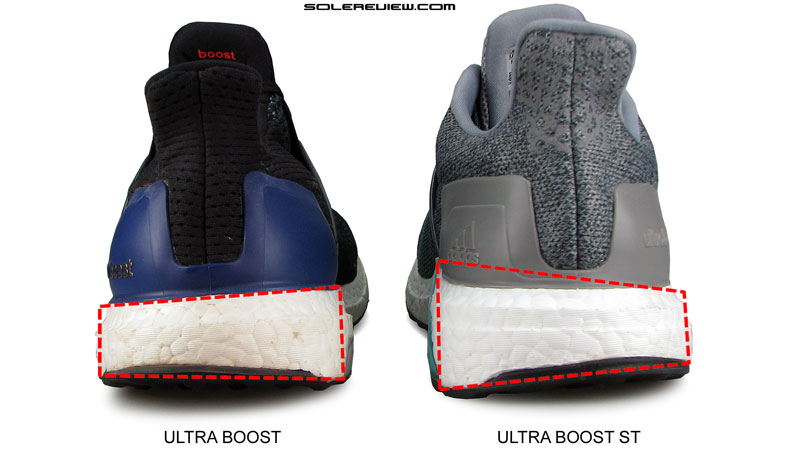
This is how the ST justifies its categorization. The medial side is significantly taller than the lateral, and especially more so than the stock Ultra Boost.
We know that the medial side of the midsole is higher than the lateral sidewall. This gives the midsole a slight skew when seen from the heel – here’s how the regular and ST versions of the Ultra Boost compare. There’s a noticeable angle, or a bevel going from lateral to medial on the ST.
Hence the Ultra Boost ST intends to control inward foot-roll by means of a midsole design which has more material under the arch side than the other side.
However, instead of doing so through a softer foam on the lateral side and a firmer foam on the medial side (also called the adidas pro-moderator construction on older models), the ST aims to deliver a motion control outcome by making the medial side more cushioned .
The effect of this unique design is quite mild. You do get this sense that there’s more foam under your arch, which actually feels quite nice. The softness of the Boost foam ensures that there’s no poke-yness.
This is not a stability or a support shoe by any standard; if anything, it is a very benign motion control shoe. It does not have any of the firmness expected of a conventional stability shoe. adidas calling the ST a stability shoe is a misnomer – this one is not.
So coming back to the original question – what exactly that does see-thru polyurethane do?
The correct way to address that question would be – what would happen if that ‘Energized stability’ component did not exist?
A high volume Boost foam midsole when left completely to its own devices, is a stability disaster. Most Boost shoes have a stabilizing rim over its midsole , or is augmented with a support casing . Without any of these support mechanisms, the midsole will simply collapse under body weight or footstrike.
Need proof? Read our review of the Pure Boost, a shoe which chose a completely unsupported Boost midsole, and ended up being a pathetic running shoe. This limitation of the Boost foam also forces adidas to create a ribbed, or ‘terraced’ design for its midsole. Meaning the midsole gets progressively wider (or flares out) on the sides from top to bottom, with the intent of inducing stability.
Given that context, the Ultra Boost ST with its extremely high medial sidewall, desperately requires a support structure. This is where the translucent green overlay comes into the picture.
It’s function is to contain excessive compression or sideways shear, and potential collapse/splaying out of the soft Boost foam. The motion control part is achieved by the beveled midsole with its higher medial sidewall; the urethane strip’s only job is to maintain the integrity of that structure and function.
It might not be a medial post in the known sense of the word, and yet it has an important role to play in the bigger scheme of things. It is certainly not a mere decoration.
The translucent urethane prevents the Ultra Boost ST from turning into a Pure Boost, and that is good enough a reason for its existence. It must be noted that this strip is flexible, so it bends with the Boost foam instead of sticking out as a hard support structure.
In a nutshell, the ‘Energized stability’ piece exists to make up for the shortcomings of the otherwise excellent Boost foam.

The Torsion plate extends till the medial heel and joins the green Urethane above it. The outsole rubber tends to shred faster under this hard area if loaded.
At the top, it does not extend under the foot but just stops a few mm inwards over the midsole edge. At the bottom, it is connected to an extension of the plastic ‘torsion’ insert, which results in the gap you see in the picture.
As a side note, the outsole tends to wear off faster just under the area where the Torsion plate meets the Urethane strip. A harder outsole there means more pressure on the soft rubber, and hence the wear.
With all the added foam material, the Ultra Boost ST ends up being a highly cushioned shoe. It is the most cushioned within adidas’s existing performance running line-up, the standard UB included. There are no firm rims or casing restricting the midsole, so the ST delivers an unadulterated Boost ride experience.
The insole is soft EVA and few millimeters thick; below that is a thick fabric lasting with plenty of open windows. Beyond that it is just the Boost foam.
And if you must know, the ST’s sockliner is different from that used inside the Ultra Boost.
The ST version pictured here is thicker, and has detailed contouring. The insole edges rise up on the sides of the midfoot and the heel. The standard Ultra’s insole was flat – here’s an image to remind you what it looked like.
As far as the ride experience goes, it is very soft, but without the mushiness of EVA midsole based models such as the Asics Nimbus 17. There is a level of responsiveness typical of adidas Boost; however all the cushioning depth gets in the way of a speedier ride.
The best way to describe the ride experience is that the ST is very well cushioned, and feels neither slow nor fast. The transition quality is also a mite lazy due to all the foam, but at the same time you don’t get the feeling you’re walking around in a pit of molasses either.
What the ST does better over the standard Ultra B is in the quality of cushioning spread. With the forefoot being significantly jacked up in terms of stack heights, the cushioning quality feels balanced, more evenly distributed. This has no negative impact on forefoot flexibility – the ST remains super bendable in the front.
The regular UB in comparison felt a bit rearfoot loaded due to its lower forefoot midsole height. The ST also feels more planted than the UB, which is a natural byproduct of its wider outsole footprint.
One would imagine that the ST would be very heavy with the over-sized Boost midsole, but you know what, it does rather well in the weight department. A US 11 weighs a shade over 350 gms/12 Oz, which isn’t bad considering the midsole is full length Polyurethane – which weighs more than EVA.
The ST is only slightly heavier than the Glide 8 Boost, which makes its bulk tolerable. Understandably, the increase in midsole volume and outsole rubber makes the ST around 20 gm/0.7 Oz heavier than the stock Ultra.
In more ways than one, the ST is a marked improvement over the standard Ultra Boost. There’s much more upper room, the plastic prison is gone, the sole grips better, and the cushioning experience is more balanced. Much like the Brooks Transcend 3, the ST is one shoe which performs the role of both a neutral and mild motion control shoe equally well.
There is some chatter about the Ultra Boost ST being a replacement for the adistar Boost. We haven’t reviewed the adistar Boost, but from the looks of that shoe, it should have a much firmer ride, a noticeable degree of medial side support, and a tight upper fit resulting from the use of stretch ESM or techfit upper.
If what we’re assuming is true, then runners seeking to switch from the adistar Boost will be disappointed by the ST’s easy upper fit and neutral ride aspect.
On the other hand, if you were considering getting the regular Ultra Boost, then we suggest that you buy the ST instead. Do not worry about the shoe’s ‘stability’ pretensions, the ST is no more of a stability shoe than the UB is.
The shoe delivers a ride experience with a strong neutral vibe, the exception being the additional soft filling under the arch. Conversely, if you’re shopping for a shoe with a firm and supportive ride (adistar users, listen up), then we’d like to point you in the direction of the adidas Sequence Boost 8.
And what can you use the Ultra Boost ST for? This is a good shoe for long and easy runs, but its ability to go far is limited not by its midsole design and ride experience. Instead, the top of the synthetic midfoot gets in the way of an otherwise comfortable experience. Then there’s the potential lack of outsole durability, which on a $180 shoe can become a pressing issue.
Transplant the midfoot design from the Glide 8 Boost, improve the outsole compound, and then adidas will have created a near flawless Ultra Boost experience. And yes, the general fit and finish standards of adidas shoes are also in dire need of improvement.
Except for these flaws, the Ultra Boost ST is an extremely comfortable running shoe. This is what the original Ultra Boost should have been in the first place.
(Disclaimer: For this review, Solereview bought the shoe at full US retail price.)
Usually, we include a match report only when comparing previous and current models. But since the Ultra Boost and Ultra Boost ST can be confusing choices, we felt that we owe to you to present a comparison. You’re welcome.

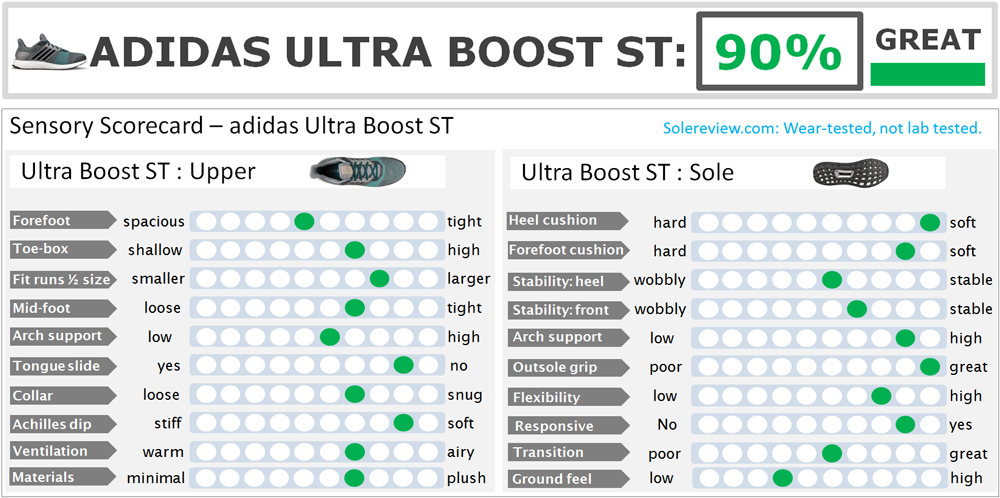


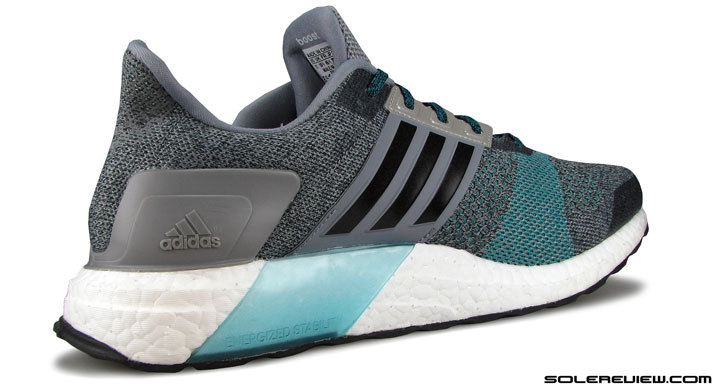
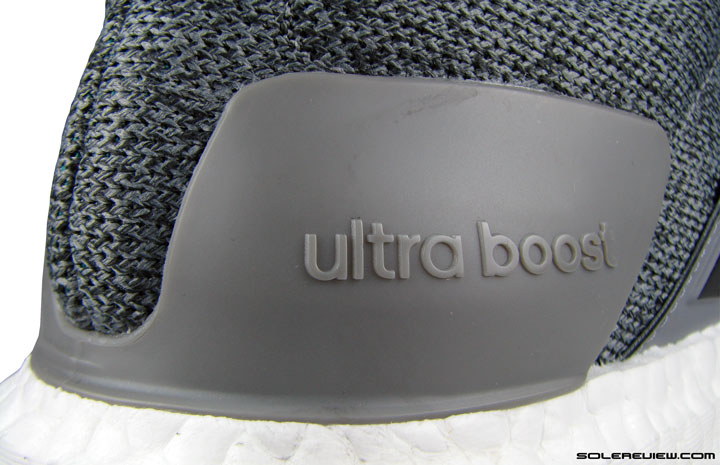

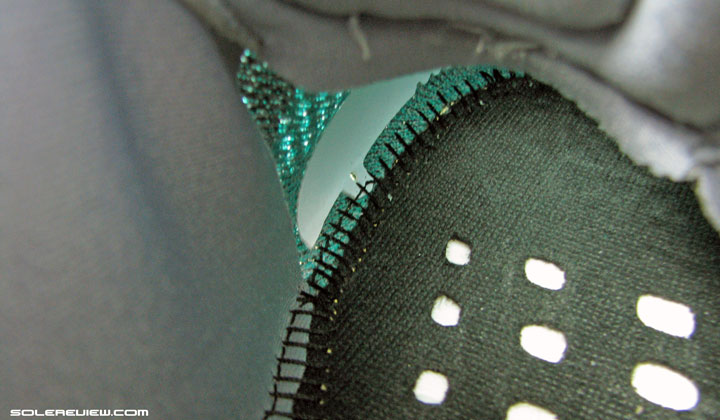


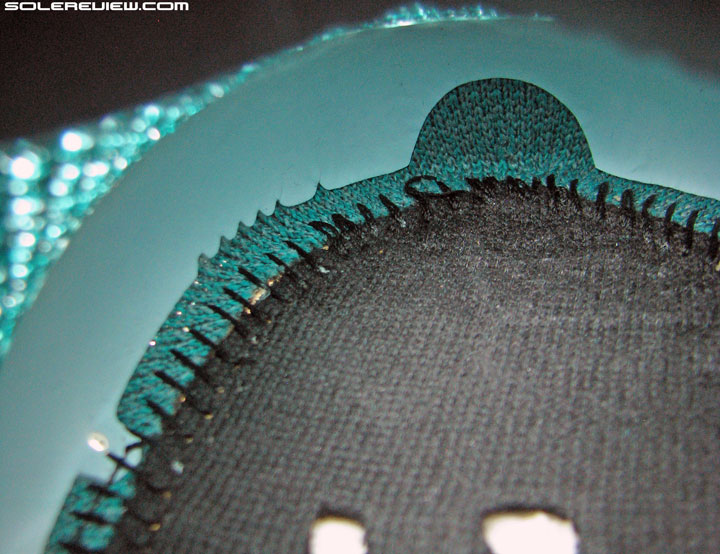
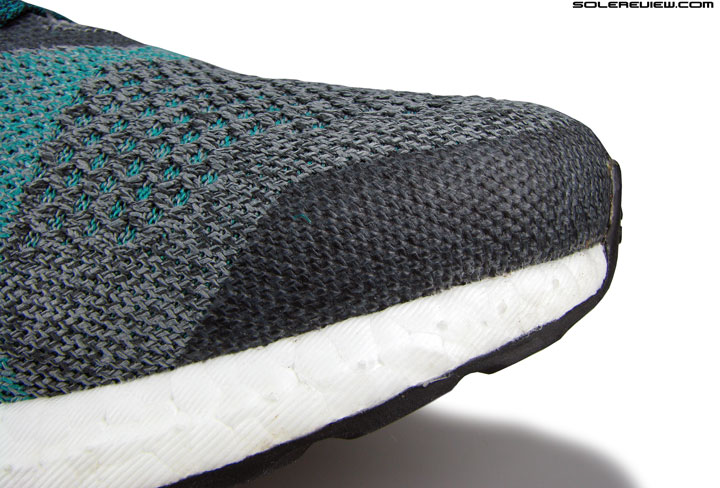


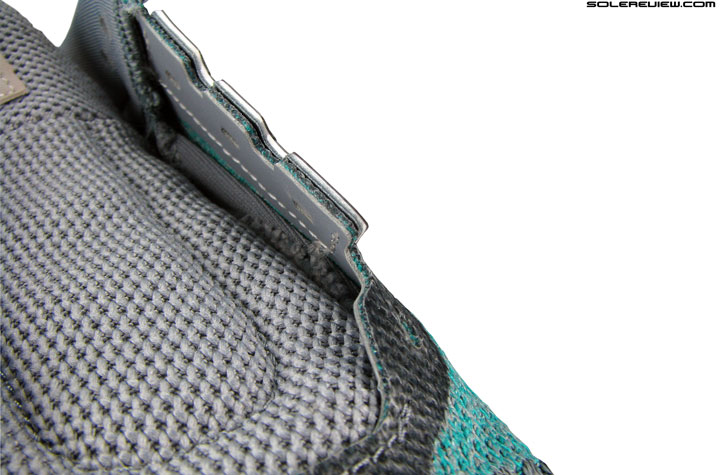
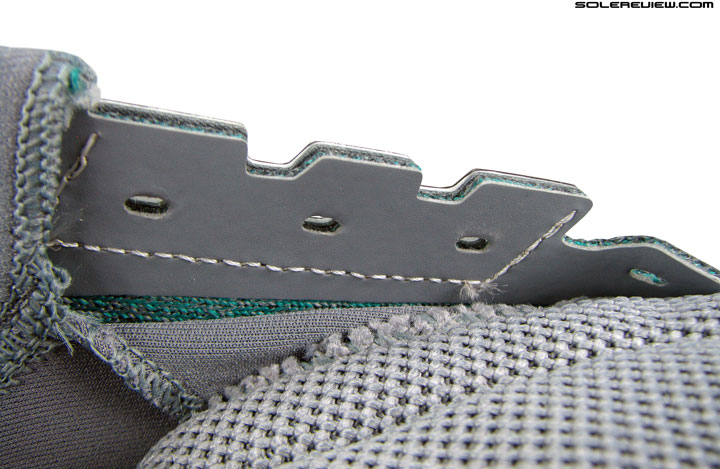


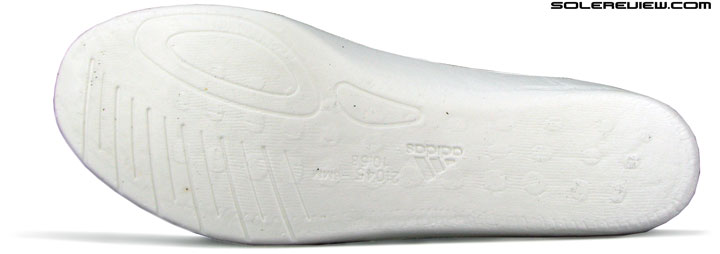



21 comments
I’ve put 700+ miles in a pair of Sequence 8s and the midsole was smoothed over after 300 but the ride hasn’t changed. Pleasantly surprised considering that the more expensive Asics shoes seem to be more expensive and last less longer.
I wouldn’t mind a more cushioned ride than the Sequence but I’m worried about the difference in stability. I’ll have to try a pair.
Would the Tempo also compliment this as a good racing shoe too do you think?
Do you mean the adizero Tempo? Yes, that’s a pared down, faster version of the Sequence. Will compliment well.
Boost midsoles will always last longer than EVA based ones used in Asics.
Now that you mentioned the Glide 8 Boost, Adidas seemed to be quiet about its release. I saw it at my local Adidas store and it’s labeled as a Glide 7. I’m confused.
Nevertheless, I might give the ST a try…. Great review!
The Glide 8 has been out for a while now, but not much has changed.
I have a pair of the second generation Ultra Boost, the non ST version that I bought in December (in the UK). These also have the Continental rubber. Due to an injury I haven’t been able to run but they are so comfortable I used them for walking and noticed the forefoot has worn down pretty quickly, after not excessive use, where as the rest of the sole is still great. I’m obviously a forefoot striker when I walk but heel strike when I run.
It depends on the loading pattern, but the ST Continental doesn’t appear to be great on durability. That was our sense, based on 50 miles of usage.
I returned my first edition ultra boosts with the rubbish pimpled outsole to adidas who offered to replace them, I asked for a pair of the second edition UB’s with the continental rubber (I already owned one pair but wanted a second) but they said they were old stock and no longer had them. This was a surprise given they only released them in the UK in late November. I can only guess that an Ultra Boost three with yet another outsole might be released before the London Marathon in April. Meanwhile my first edition adidas energy boost have minimal wear on the outsole after hundreds of miles.
That is interesting.
Brilliant review, as always. Disappointing that this is not a stability shoe – I was excited at the prospect of being able to try-out Boost. The Supernova Sequence are too narrow for my feet, so that leaves no more options from adidas for me!
Such a narrow range of support shoes is disappointing from a company supposedly serious about sports as well as fashion.
Not your typical stability shoe, yes.
I bought a pair of STs hoping they would be a good marathon shoe. Man, have I been disappointed! I have unusual flat, yet narrow feet, and was convinced by Adidas’ marketing of this shoe that it would provide the touch of stability I’m looking for along with a good amount of support and cushioning to go long. The hard cages of the UB kept me from ever making a purchase since I knew they would become very uncomfortable around my lower arches. But the more flexible wrap arounds of the ST ended up being very uncomfortable as well. They would flare out in the back, while pinching my feet at the front – as if they were designed for a very specific foot shape which obviously is not mine. But the main reason I cannot wear these shoes – even as daily walk arounds – is the midsole build up under the arches. After a few miles, it begins to feel like I am being hammered in the arch on each step. Very painful! I had hoped it was a “break in” thing, but it only got worse. And if you feel from the inside with the insole removed, you can feel how there is a good half-inch lip rising from the outside of the midsole in addition to the overall build up of material. It’s like running a small bar under your arch. Typically, “stability” shoes have worked well with my low arches, but these are definitely not intended for those of us with flat, janky feet. Wish I could have read your great review before purchasing so I could have been aware that this was not the supportive, long miles shoe I was hunting.
Thank you for the detailed feedback, Dennis. We can see that the pronounced under-arch area might not work well for everyone.
I am wearing transcend 2 – need the cushion and some firmness as well as the “guiderails” as I hit lateral heels and right ankle rolls in moderately. Would this be a good shoe to try.
No, the ST is way softer than the Transcend. The reason why we mentioned the ST and Transcend together is because they are both ‘neutral’ stability shoes.
Amazing reviews! I’m currently looking for a new pair of runners and this website has been amazing for someone as information-hungry as I! Seeing as you have been kind enough to respond to other readers’ questions about recommendations, I was hoping you could do the same with me. I am 6 ft. 160 pounds and run 5-7 miles four times a week. I currently run in the Brooks Ghost 8, however I slightly miss the lightweight and responsiveness of my old Pegasus 31s. I have had a history with some knee problems, so I realize my longing for a lighter shoe will counteract the cushioning it will provide. My question is, are there any options in the middle of the two shoes which can satisfy my needs? One other thing, my feet are ‘borderline’ wide. My Ghost 8s are in a 2E width, as recommended by my local running shop, however I do have to tie them quite snugly to get the fit I like. Thank you again!
We’ve heard good things about the Brooks Launch (now V3 available), though haven’t tested them personally.
Ok, I’m intrigued by the boost material. I’ve got a pair of A6 nimbus 17 that I find too soft and pillowy. Would I like boost material and which version is the best to get the “boost” experience? I like neutral shoes that are soft but have good heel to toe transition.
Thanks.
The Ultra Boost ST comes pretty close, and if you want something firmer and faster, the Glide 8 Boost will do it for you.
Hello SoleReview:
Once again, thank you for your thorough and detailed review! I have been a long-time fan of your review site, and am particularly drawn to your impartialness and the level of depth involved in your analysis of each different running shoe. This review for the adidas Ultra Boost ST couldn’t have come at a better time for me, as I have a question for you.
I am male, 28 years old, 5’11”, 140 lbs., and have been a mid- to long-distance (half marathons here, occasionally a full or ultra marathon there) runner for several years now. Although my feet are actually wide (I believe, E or very rarely 2E, depending on the footwear manufacturer), I have been fortunate to fit into D (normal) running shoes in the past. So far, my arsenal of running shoes are: Nike LunarGlide 7 (size 11D), Brooks Launch 2 (size 11D), adidas Supernova Glide 6 Boost (size 11D), and Nike Flyknit Lunar 3 (size 11D). As a matter of fact, my Nike and adidas purchases were based on your previous reviews, and they have been excellent fits for me, so thank you very much!
Now, my question is regarding the sizing of the Ultra Boost ST. I read in your review that most runners can size down half-size and this would not cause any discomfort or problems given the ample internal room of the Ultra Boost ST. As mentioned above, I wear a 11D in the adidas Supernova Glide 6 Boost and was wondering if I can get away with a size 11 in the Ultra Boost ST or if I should size down to 10.5 (in your review, you made this size-down reference for runners with experience in the original iteration of the Ultra Boost and the Energy Boost 2 only). For me, adidas was a tough choice in the past given their harshly pointy and narrow toe boxes, as particularly seen in their Energy Boost 2 (luckily, the Supernova Glide 6 Boost had ample space in the front and the width was forgiving).
Once again, I cannot thank you enough for your reviews and this website. Also, thank you in advance for your assistance in regarding your recommendation on shoe size with the Ultra Boost ST.
You should get the 11 D, as you have in the Glide and Lunarglide!
Hi there!
I am looking for a new pair of running shoes (I wish to run 10k). The sole of the running shoes I have now are hard, not resilient at all and hurt my ankles.
I think this shoe might not be the pair I am looking for, but what would you recommend?
(Female, narrow feet, 5’7″, 112,4 lbs)
Comments are closed.